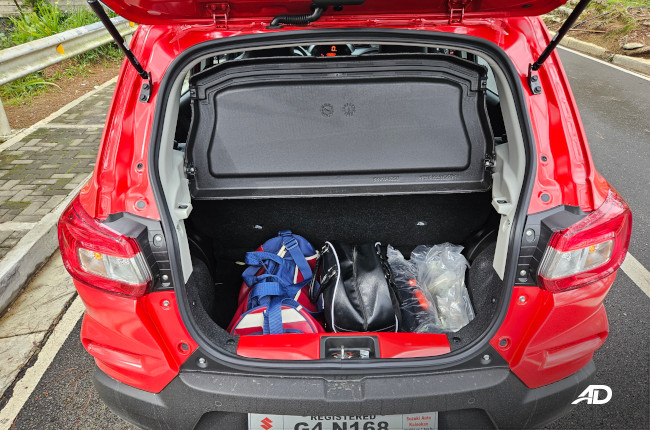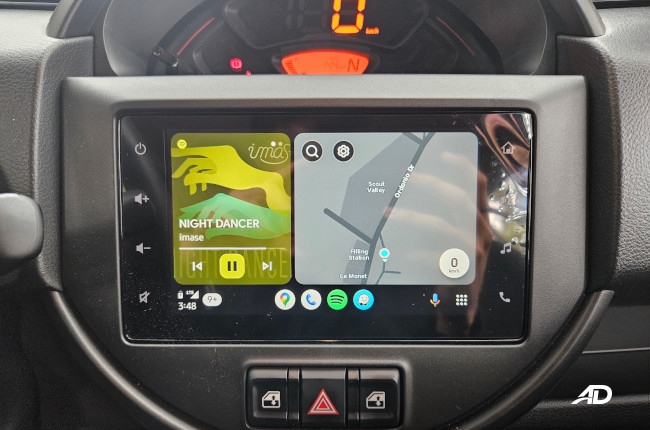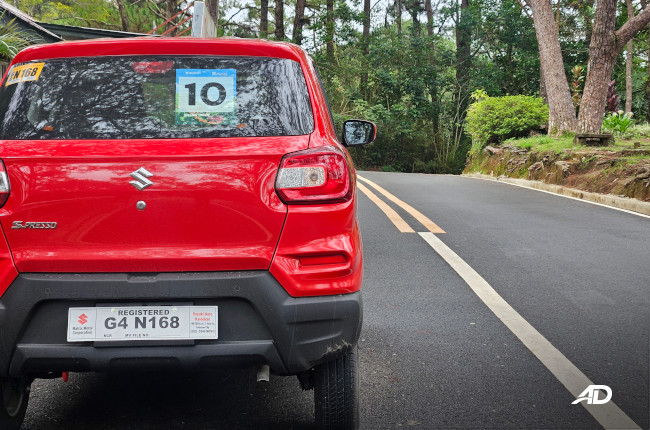
The S-Presso got an update earlier in 2023, and as the newest model to grace the lineup, Suzuki Philippines took us out on a drive to test out its brand-new small hatch. The classical small car test of “Can it go up Baguio” was the theme of this adventure with the S-Presso.
In a previous review, we were able to bring up a Celerio with a similar transmission and engine combo up to the mountain city. As we recall, there were a few features that could have sweetened the trip, features that the S-Presso now has. Here are our first impressions of the new Suzuki S-Presso AGS.
Exterior Impressions
Not much has changed. For this variant, we get a new set of wheels, and that’s pretty much it. The rest of the exterior stays largely the same, apart from very minute details that most people won’t be able to pick out at a glance. Hint, look at the badges. It’s safe to say that the S-Presso is as cute and as cheery as ever. The little hatch retains all of its charms with the quirky grille, the endearing headlights, and also lower cladding at the front and rear bumpers.
Tech-wise, the lighting array has stayed the same, in which we get halogen headlights with no fog lamps or daytime running lights (DRLs). The wheels come in at 14 inches, still, but it’s no longer an optional extra and standard on the new top-of-the-line model. All-in-all, it’s nothing we haven’t seen before, but the improvements can be found in the cabin.
Interior Impressions

The interior of the S-Presso comes wit hall the same trimmings and panels, again, nothing new. Design-wise, it’s still a bit basic. Suzuki uses plastic on all the interior panels and surfaces, which is indicative of the model’s affordability and price tag. That’s not a knock on the car, for two reasons. As mentioned, the car’s affordable, so we can’t really complain. Next, the design distracts from the plastics and is well-executed and in line with the S-Presso’s overall endearing design. With a more pessimistic approach, however, it is quite entry-level, but that’s fine because it kind of is. We were hoping that the rear windows would have gotten an upgrade with electric motors.
Otherwise, all the leg, head, and shoulder room remains the same. The shoulder room is still tight if you want to seat five people in the cabin, however, legroom is still surprising, as well as the unprecedented amounts of headroom that can fit taller individuals with no problems. The cargo space is the same, and we were able to fit all of our overnight bags in the 240-liter trunk. It’s as usable as ever, but it’s likely that anything more than a bunch of overnight bags would be a tight fit.
Tech and Safety Improvements
Suzuki made a big deal out of its newest features which also include a new electronic stability program. On the way up, we encountered many twists and turns on the road plus some heavy rain, and thankfully didn’t have to use it. Hill hold control was quite useful when traffic pilled up on the road leading up to Baguio. The two-second window that you have to prevent rollback is great and mitigated the need to jump from the accelerator onto the brakes immediately. Engine Auto Start Stop was also a heavily advertised feature for saving fuel, and it did save us a few drops at the stops.
Perhaps the biggest and most meaningful improvement will have to be the infotainment system. Coming in at seven inches, and now with Apple CarPlay and Android Auto, the Smartphone Linkage Display Audio seems like a remarkable upgrade over the previous non-AGS S-Pressos. The infotainment experience is supplemented by steering wheel controls, and an integrated microphone for taking hands-free calls.

Other small things include powered side mirrors, a rear defogger, and also hill hold control, which came in handy when we encountered stops up inclines. Apart from that, electronic stability control is new for the AGS variant, but thankfully the system wasn’t tripped during our drive-up.
Driving impressions
The start of the trip began with a full tank of gas. In true Suzuki media drive fashion, we had only one tank of gas to make it to the summer capital of the Philippines, Baguio, but more on that later.
Anyway, our car set off for our first obstacle, city traffic, something which the Suzuki S-Presso handled fairly well. We have experience with AGS transmissions in the past, and it’s the same story here. Smoother in manual mode and a little delayed in ‘D.’ It’s fair to say that the transmission isn’t exactly telepathic in terms of its operation, but it managed the city well enough with a little convincing from the accelerator pedal. Through it all, however, we managed to remain comfortable in the car with cool heads as we were able to squeeze into the cracks and crevices that no SUV or van would dare enter.
Next on our journey was a highway. Luckily, there wasn’t a lot of traffic, so we got to test the S-Presso’s expressway chops. Noise, vibration, and harshness only started to show if you really looked for it, otherwise, all the noise at about 90 km/h wasn’t intrusive, given that we played a bit of background music to supplement our road trip.

Following the highway, we went up a bit of provincial road which was laden with imperfections, as well as the road leading up to Baguio City, Marcos Highway. It was a little bit of a struggle with the car, given that we wanted to make the most out of our drive and explore that “zippiness” and “energy” the Suzuki was going on about. There was a bit of traffic on the road, but the Suzuki was able to climb the inclines of Marcos Highway, albeit with a little difficulty when overtaking. So, yes, the S-Presso can go up Baguio, but the smallness of the engine starts to show on the steep inclines, and the AGS was a little hesitant if it wasn’t put into manual mode. With only 66 hp and 89 Nm of torque, the S-Presso felt just okay on both the highway and the twisties. It is zippy because of how it is geared, but it is by no means a fast trailblazer of a hatchback. While in manual mode, however, it was quite fun to row through the gears, but going through the corners is another thing.
The S-Presso has some pretty basic suspension, which resulted in a ride that was a bit bouncy, and a chassis that felt quite hollow. On a smoothly-paved section of road, it was fine, but on the bumpy concrete of Marcos Highway, it was a little jarring, but not too unsafe by any means while going up at an average speed of about 40 km/h less the slowdowns. The thing is, the S-Presso is mainly a city car, so telling it to go to Baguio may be a little out of its comfort zone, but it can still rise up to the challenge and do it, just not as great as some other more powerful cars, but still, it will do it.
Fuel consumption

After we mixed city, expressway, and provincial highway economy figures we ended up with a reading of 14.4 km/L on our multi-information display. We feel that the city wore down the figure quite a bit as we encountered a long stop while trying to get on the highway. Following that, the steep inclines of our trip also took its toll on the fuel economy figure, so it could have been higher if there were fewer people on the road stopping and making us use the hill hold control function.
Initial verdict

After our first drive with the S-Presso, we can safely say that it’s quite novel to drive in and out of the city. The AGS transmission actually takes away a bit of the fun that the five-speed manual transmission brought to the table, but the AGS is a decent option for those that demand a manual transmission without a clutch. We think that the AGS transmission could use a bit of polish or human intervention, and it’s a good thing that you can intervene with the supplied manual mode on the gear selector.
Otherwise, the engine is just about enough for the car. Don’t get us wrong, it’s not a fast engine nor is the S-Presso a fast car. For starters, we had a lot of fun going slow and safe up the mountain roads going to Baguio since the experience was rather raw and engaging. Now that can be a good or a bad thing depending on how you look at it, with all the bumps and potholes getting in the way of a smooth ride, but where’s the fun? Where’s the drama?
The S-Presso is more raw than refined, but we were all kind of smiling ear-to-ear while driving it and wondering if it will make it up the steep inclines. The thing is, it did, so end of the story, right? Well, that depends. Frankly, and based on our experience with the Celerio, it’s largely the same but with a more impressive tech package. It’ll actually be interesting to see just how well the S-Presso will fare in a full review.
Specifications
Engine
1.0 LFuel Type
GasolinePerformance
66 hp @ 5,500 rpmTransmission
Automatic-
Summary
-
Name Suzuki S-Presso GL AGS Body Type Hatchback Price ₱674,000 Transmission Category Automatic -
Engine
-
Engine Size 1.0 L Displacement 998 cc Number of Cylinders 3 Number of Valves 12 Transmission Type 5-speed Auto Gear Shift -
Performance
-
Drivetrain Front-Wheel Drive Max Output (hp) 66 hp @ 5,500 rpm Max Torque (nm) 89 Nm @ 3,500 rpm -
Economy & Environment
-
Fuel Type Gasoline Emissions Standard Euro 4 Fuel Capacity 27.0 L *Combined Fuel Consumption 14 km/L *brand manufacturer claim
-
Dimensions
-
Length 3,565 mm Width 1,520 mm Height 1,657 mm Wheelbase 2,380 mm Turning Circle 9 m Ground Clearance 180 mm Trunk Capacity 239 L Number of Doors 5 Number of Seats 5 -
Safety & Security
-
Driver's Airbag 1 Front Passenger's Airbag 1 Side Airbag Curtain Airbag Knee Airbag Auto Brake System Electronic Brake Distribution Anti-lock Brake System (ABS) Electronic Brake-force Distribution (EBD)
Immobilizer Security Alarm Stability Control Electronic Door Locks Speed Sensing Door Locks ISOFIX Lane Departure Warning System Blind-Spot Detection System -
Features
-
Cruise Control Front Parking Sensors Rear Parking Sensors Leather Upholstery Push Start Button Wheel Size 14 in Wheels Metal Type Alloy Airconditioning System Manual Cooler, Dial Type Control Entertainment System 7" Touchscreen, New Generation Display Audio Connectivity Smartphone linkage (Androids/IOS),Bluetooth and USB Navigation Ready Warranty 5 Years (100,000 km); FREE 1-Year Periodic Maintenance Service Keyless Entry Roof Rack Sunroof Electric Adjustable Seats Power Steering Power Windows Power Outlet Steering Wheel Audio Control -
Technology
-
Active Park Assist Hill Start Assist AWD Modes n/a Tire Pressure Monitoring Heads-up Display Power Liftgate Start-stop System
Colors
Latest Review
-
2025 BAIC B30e Dune 4x4 HEV Review / Review
After 1,000 km behind the wheel of the BAIC B30e Dune, we share what we loved about this hybrid and what we don’t.
4.2 / 5 -
2025 MG G50 Plus Lux DCT Review / Review
Can affordable price and VIP aspirations blend together? We find out in this review of the MG G50 Plus Lux DCT.
4.0 / 5 -
2025 BYD Seal 5 DM-i Premium Review / Review
We test-drove the BYD Seal 5 DM-i, and its features and affordable price make it a strong hybrid sedan contender.
4.2 / 5
Popular Articles
-
Cheapest cars under P700,000 in the Philippines
Jerome Tresvalles · Sep 02, 2024
-
First car or next car, the Ford EcoSport is a tough package to beat
Jun 18, 2021
-
Car Maintenance checklist and guide – here’s everything you need to know
Earl Lee · Jan 12, 2021
-
Most fuel efficient family cars in the Philippines
Bryan Aaron Rivera · Nov 27, 2020
-
2021 Geely Okavango — Everything you need to know
Joey Deriquito · Nov 19, 2020
-
Family cars in the Philippines with the biggest trunks
Sep 20, 2023
-
Head to head: Toyota Rush vs. Suzuki XL7
Joey Deriquito · Oct 28, 2020
-
Why oil changes are important for your car
Earl Lee · Nov 10, 2020
-
2021 Kia Stonic — What you need to know about it
Joey Deriquito · Oct 16, 2020
-
Top 7 tips for buying a used car in the Philippines
Joey Deriquito · Nov 26, 2020
































